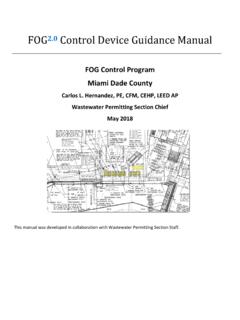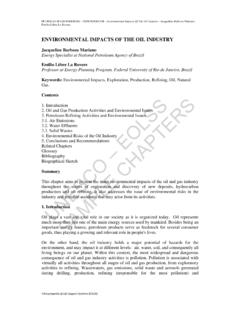Transcription of Glossary of Terms - US EPA
1 Glossary of Terms This Glossary includes a collection of the Terms used in this manual and an explanation of each term. To the extent that definitions and explanations provided in this Glossary differ from those in EPA regulations or other official documents, they are intended for use in understanding this manual only. 401(a) Certification A requirement of Section 401(a) of the Clean Water Act that all federally issued permits be certified by the State in which the discharge occurs. The State certifies that the proposed permit will comply with State water quality standards and other State requirements. Acute A stimulus severe enough to rapidly induce an effect; in aquatic toxicity tests, an effect observed in 96 hours or less is typically considered acute.
2 When referring to aquatic toxicology or human health, an acute effect is not always measured in Terms of lethality. Anti-backsliding A provision in the Federal Regulations [CWA 303(d)(4);. CWA 402(c); CFR (l)] that requires a reissued permit to be as stringent as the previous permit with some exceptions. Antidegradation Policies which ensure protection of water quality for a particular water body where the water quality exceeds levels necessary to protect fish and wildlife propagation and recreation on and in the water. This also includes special protection of waters designated as outstanding natural resource waters. Antidegradation plans are adopted by each State to minimize adverse effects on water.
3 Authorized Program or Authorized State A State, Territorial, Tribal, or interstate NPDES program which has been approved or authorized by EPA. under 40 CFR Part 123. Average Monthly Discharge Limitations The highest allowable average of daily discharges over a calendar month, calculated as the sum of all daily discharges measured during that month divided by the number of days on which monitoring was performed (except in the case of fecal coliform). Average Weekly Discharge Limitation The highest allowable average of daily discharges over a calendar week, calculated as the sum of all daily discharges measured during a calendar week divided by the number of daily discharges measured during that week.
4 NPDES Permit Writer Training Manual - G-1. Glossary of Terms Best Available Technology Economically Achievable (BAT) . Technology-based standard established by the Clean Water Act (CWA) as the most appropriate means available on a national basis for controlling the direct discharge of toxic and nonconventional pollutants to navigable waters. BAT effluent limitations guidelines, in general, represent the best existing performance of treatment technologies that are economically achievable within an industrial point source category or subcategory. Best Conventional Pollutant Control Technology (BCT) Technology- based standard for the discharge from existing industrial point sources of conventional pollutants including BOD, TSS, fecal coliform, pH, oil and grease.
5 The BCT is established in light of a two-part cost reasonableness . test which compares the cost for an industry to reduce its pollutant discharge with the cost to a POTW for similar levels of reduction of a pollutant loading. The second test examines the cost-effectiveness of additional industrial treatment beyond BPT. EPA must find limits which are reasonable under both tests before establishing them as BCT. Best Management Practice (BMP) Permit condition used in place of or in conjunction with effluent limitations to prevent or control the discharge of pollutants. May include schedule of activities, prohibition of practices, maintenance procedure, or other management practice.
6 BMPs may include, but are not limited to, treatment requirements, operating procedures, or practices to control plant site runoff, spillage, leaks, sludge or waste disposal, or drainage from raw material storage. Best Practicable Control Technology Currently Available (BPT) The first level of technology-based standards established by the CWA to control pollutants discharged to waters of the BPT effluent limitations guidelines are generally based on the average of the best existing performance by plants within an industrial category or subcategory. Best Professional Judgment (BPJ) The method used by permit writers to develop technology-based NPDES permit conditions on a case-by-case basis using all reasonably available and relevant data.
7 Bioassay A test used to evaluate the relative potency of a chemical or a mixture of chemicals by comparing its effect on a living organism with the effect of a standard preparation on the same type of organism. Biochemical Oxygen Demand (BOD) A measurement of the amount of oxygen utilized by the decomposition of organic material, over a specified time period (usually 5 days) in a wastewater sample; it is used as a measurement of the readily decomposable organic content of a wastewater. G-2 - NPDES Permit Writer Training Manual Glossary of Terms Bypass The intentional diversion of wastestreams from any portion of a treatment (or pretreatment ) facility.
8 Categorical Industrial User (CIU) An industrial user subject to national categorical pretreatment standards. Categorical pretreatment Standards Limitations on pollutant discharges to publicly owned treatment works promulgated by EPA in accordance with Section 307 of the Clean Water Act that apply to specified process wastewaters of particular industrial categories [40 CFR and Parts 405-471]. Chemical Oxygen Demand (COD) A measure of the oxygen-consuming capacity of inorganic and organic matter present in wastewater. COD is expressed as the amount of oxygen consumed in mg/l. Results do not necessarily correlate to the biochemical oxygen demand (BOD) because the chemical oxidant may react with substances that bacteria do not stabilize.
9 Chronic A stimulus that lingers or continues for a relatively long period of time, often one-tenth of the life span or more. Chronic should be considered a relative term depending on the life span of an organism. The measurement of a chronic effect can be reduced growth, reduced reproduction, etc., in addition to lethality. Clean Water Act (CWA) The Clean Water Act is an act passed by the Congress to control water pollution. It was formerly referred to as the Federal Water Pollution Control Act of 1972 or Federal Water Pollution Control Act Amendments of 1972 (Public Law 92-500), 33 1251 et. seq., as amended by: Public Law 96-483; Public Law 97-117; Public Laws 95-217, 97-117, 97-440, and 100-04.
10 Code of Federal Regulations (CFR) A codification of the final rules published daily in the Federal Register. Title 40 of the CFR contains the environmental regulations. Combined Sewer Overflow (CSO) A discharge of untreated wastewater from a combined sewer system at a point prior to the headworks of a publicly owned treatment works. CSOs generally occur during wet weather (rainfall or snowmelt). During periods of wet weather, these systems become overloaded, bypass treatment works, and discharge directly to receiving waters. NPDES Permit Writer Training Manual - G-3. Glossary of Terms Combined Sewer System (CSS) A wastewater collection system which conveys sanitary wastewaters (domestic, commercial and industrial wastewaters) and storm water through a single pipe to a publicly owned treatment works for treatment prior to discharge to surface waters.











